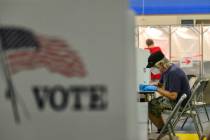Color-coding the brain is useful, but is it worth the cost?
Turns out, I’m a green, with a fairly large dose of blue.
After I read recently about the Clark County School District spending $350,000 over the past six years with a company called Emergenetics, I was curious. The company uses a 100-question survey to gauge a person’s basic thinking tendencies, with the goal of improving communication and cooperation. The school district has given the survey to about 1,630 of its employees, including the Board of Trustees, the superintendent and top staffers.
So, I asked if I could take the test, and sit down to discuss the results with Emergenetics consultant Erik Kieser.
I admit, I was skeptical going in. Like Hannibal Lecter in “Silence of the Lambs,” I wondered if Emergenetics thought it could dissect me with a blunt little tool. But, after I’d taken the test, Keiser explained that it’s not a personality test as much as a way to figure out the basic ways people think. And it was surprisingly accurate.
My major category, at 55 percent, was green, for structural thinkers. According to the test, I like to bring order out of chaos, I’m organized, practical, ill-tolerant of mistakes and a linear thinker. I like to accumulate data and have a good memory for details. And I’m hyper aware of time. All of those things are true.
My second category, at 34 percent, was blue, for analytical. This category applies to people who analyze data for patterns, who are rational, logical problem solvers and who look for ways to rapidly assess information and move on. Again, all true.
What I’m not, apparently, is a conceptual thinker, people who are more imaginative, visual, who like to play with ideas, big-picture dreamers who don’t like boundaries and aren’t all that concerned with time. And I’m definitely not a social thinker, whose thinking focuses on relationships, who solve problems by talking about them out loud and who are collaborative.
Furthermore, the analysis showed, I’m not a big fan of change, which is also true.
So, now what? And what does all of that have to do with the school district spending a princely sum on thinking tendency analysis for a regiment’s worth of employees?
“If people are going to work together, they’re going to have to communicate,” Kieser said, after explaining my survey results to me. “Most of the participants are taking this information and doing something with it.”
After having taken the survey myself, I can see the utility. If I know, for example, that someone is a conceptual thinker, and that I’m a structural thinker, I know our styles could easily clash, and I’ll be on the lookout for ways to relate to that person on his or her terms. Working together in a group — say the Board of Trustees — could go much more smoothly if everyone is aware of the thinking tendencies of others.
District Chief of Staff Kirsten Searer said in an email that she’s witnessed greater productivity, fewer conflicts, easier resolutions to conflicts that do arise and improved morale among employees who have worked with Kieser and the Emergenetics assessment. She’s also said she’s seen changes in how the district communicates to its employees based on different thinking styles.
So perhaps the question isn’t, is this worth it, but rather, do the obvious benefits justify the cost, especially in a district that badly needs to improve its graduation rate, its success rate on standardized tests and to build new school campuses? That question is harder to quantify.
How much is better communication worth, after all? My structural/analytical brain wonders if there’s a way to put a dollar value on employees understanding each other better, and working together more effectively. I found the Emergenetics information to be undeniably valuable, and it’s apparently produced tangible improvements in how the district runs, but is it critical to the district’s core mission, educating students and preparing them for success in higher education and the workforce? Perhaps that’s a question better addressed to a yellow/red thinker?
Steve Sebelius is a Review-Journal political columnist who blogs at SlashPolitics.com. Follow him on Twitter (@SteveSebelius) or reach him at 702-387-5276 or SSebelius@reviewjournal.com.

















